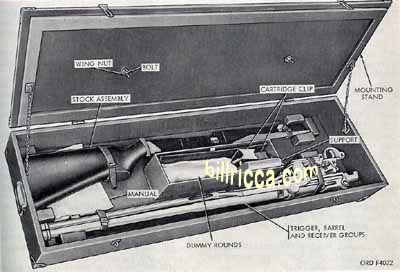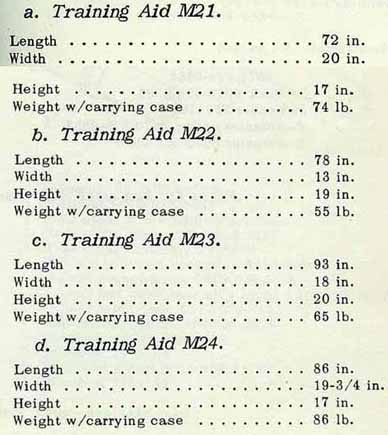Military Training Aids- Double Size Trainers (2X)©
Training Aids (TA's) is an all encompassing term. It covers Graphic Training Aids (GTA's) and Training Devices (DVC's). A GTA is two dimensional; a DVC is three dimensional. You may hear them referred to by additional names. Training aids were produced as Transparencies, Sub Caliber Devices, Simulators, Transparent Overlays, Instructional Charts, and in many other forms too numerous to list. The format can be as simple as adjusting the sight of a rifle, or as complex as a series of mechanical steps taken in an emergency situation in a jet fighter. Training aids weight less than an ounce and can exceed several thousand pounds. Films and film strips usually had separate listings.
This short history will deal only with oversize training devices developed for small arms instruction. The period of time covered is from the 1940's to the year 1980. The first area covered is what I refer to as the "M" series. These were the only ones given an "M" designation.
It was originally the Navy that contracted for this series of trainers. The series consists of the M21 thru M24 and the common contract dates are 1951-53. Each trainer consisted of a model twice the size of the original weapon, made of wood, aluminum, zinc castings, and steel. Each one came in its own carrying case which converted to a display stand. I am not far along in the search for contractors. Dellenbarger is the only one I have so far. I am hoping this webpage will bring in new information.
I have listed the accessories that accompanied each of the M series Training Devices. Each device had a variety of quantities of spare parts. The spares included those small parts that were easily damaged, lost, or worn out. There was also a support system to keep spare parts stocked and supplied when needed. Major components like spare bolts, breech locks, barrel extensions, trigger housings, and operating parts were contracted separately, in very limited quantities. It was the scarcity of these major components that led to the eventual cannibalization of these units as the 1960's approached. In today's market very few exist as originally contracted. Most are missing either the carrying case, magazines, clips, or contractor manual.
Although the Navy did the original procurements, the Army ended up supporting and using a large quantity of them. Raritan Arsenal had the responsibility to manage these devices for a short time. That responsibility ended when Raritan closed in the mid 1960's. Raritan also assembled the information for the first Technical Manual in September 1962.
In the Army, these training devices were used for classroom instruction in basic and advanced training centers. They were also loaned to TO&E units on an "as needed" basis. The training aids were stocked and supported at a regional "Training Aids Center" or "Training Aids Supply Office", depending upon the time period. During the 1960's two of the largest were Fort Jackson and Fort Benning. The M Series devices were lightweight versions of the actual item. The long bulky dimensions and lightweight components made them susceptible to damage. These centers were set up to store, transport, issue, and maintain them.
A quick word about Army device numbers. The "9" prefix shows an ordnance responsibility.
Carbine Training Aid M21, PN 7268241 (US Carbine Cal. .30 M2)

Originally contained 24 cartridges, two magazines and contractor supplied manual.
Navy 3F4, Army DVC 9-4

M21 packed for storage and travel.
Machine Gun Training Aid M22, PN 7268244 (M1919A4/A6 Cal. .30 BMG)

Originally contained 24 cartridges, two cloth belts, and contractor supplied manual.
Navy 3F7, Army DVC 9-6


The two above illustrations show the transition from travel to display. The basic system applies to all in this series.
Rifle Training Aid M23, PN 7268242 (M1918A2 BAR, Cal. .30)

Originally contained 24 cartridges, two magazines, one contractor supplied manual, and 2 disassembly mats. This is the only trainer of the M series that included mats.
Navy 3F3, Army DVC 9-7

M23 packed for storage and travel. Notice disassembly mats listed next to nomenclature.
Rifle Training Aid M24, PN 7268243 (US Rifle Cal. .30 M1)

Originally contained 24 cartridges, two enblocks, one contractor supplied manual.
Navy 3F5, Army DVC 9-5

M24 packed for storage and travel.


Green: Originally delivered with the Dellenbarger contract.
Yellow: The only thing confirmed about this cartridge is its existence. I suspect it may have been used with the 50 caliber trainer shown below. The scarcity of this cartridge probably coincides with the number of DVC 23-3's used within the system, very few. In later years there was less importance put on the use of large mock-ups, which resulted in smaller quantities. This cartridge is possibly from the late 1960's, or possibly even later.
Black: Replacement cartridge. As late as the 1978 Letterkenny had thousands in storage. My large supply was released on gov't bid circa early 1980's.
Non "M" Series, Enlarged
There were also a quantity of devices that had no M designation. They were cataloged by their device number.

Army Device DVC 23-2, Scale 12:1
This wooden device had operable windage and elevating knobs and reactive aperture and sight base. Units were encouraged to produce it locally as it was fragile and very few survived.

Army Device DVC 7-5, M1 Sight Picture Data. Originally developed for use with the M1 Rifle, it was still in use in 1980 for the M16. Pivoting levers were used to adjust the target and/or sight, showing instructor and student the correct or incorrect sight picture.

Army Device 9-9, Rear Sight Data for the 1919A6 BMG. Listed as A6 because the A6 was the latest design, but would also apply to the 1919A4. This was a large wooden device which was authorized for local fabrication. This DVC 9-9 designated device would be superceded by the M60 equivalent circa 1961, shown below.

Army Device DVC 9-19 for the M16A1. Total weight 130 lbs.

Army Device DVC 23-5 for the M60 MG. Unlike others that have a "9" prefix, this one's 23 designates the original responsibility was Infantry, and probably was developed at Fort Benning. Later publications show 23 as being Infantry Weapons.

Army Device DVC 9-9, M60 Rear Sight Data. A large wooden device which is used to demonstrate windage and range settings on the rear sight leaf. First referenced in 1961 with just text and no illustration.

DVC 23-3 for the M2 .50 BMG. Largest small arms device as of 1980. Operated with a 110 volt 1/3 hp motor and was not for general distribution. Production was very limited and was seldom used due to the size and complications of design. Device had 30 dummy cartridges which, upon extraction, dropped into a collection area inside the cabinet. A clever design, this unit operated the action in slow motion (7 rounds per minute) to allow the students to see the relationship of all moving parts as the gun cycled. I suspect this unit used the yellow dummy cartridges pictured above.
What is next? I am still trying to find information on the double size mock ups for the M14 Rifle and the 1911A1 Pistol. I have seen both trainers over the years, but never have found anything written about them. I am also seeking information on the late war M1 Carbine mock ups that were produced at Aberdeen and other facilities.
I am also seeking information on the M series as to serial numbers and dates, and information on any other contractors. The search continues.
This information may be used freely for message boards discussions. Permission must be granted for use on websites, for publication, or for inter-net auctions. Don't be afraid to ask, you may be surprised.
All inquiries regarding this research project must be by email.

